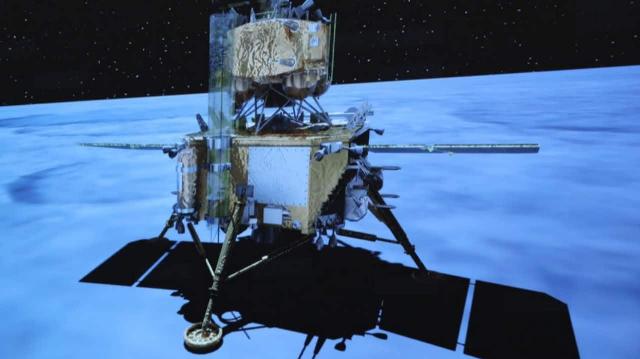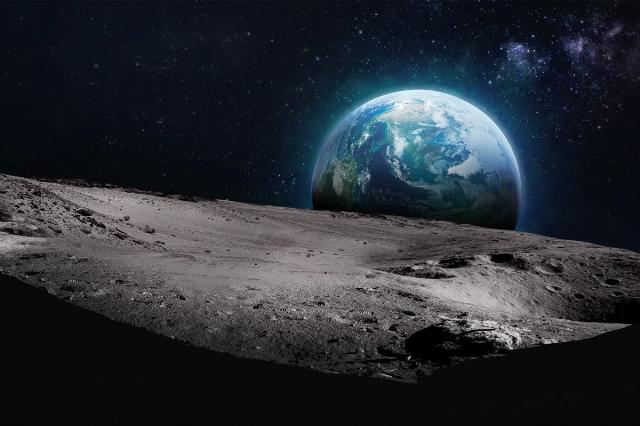The developers from China stated that the Chang'e-7 mission includes a jumping robotic platform. It is used to explore the south pole of the Earth's satellite, and before the expected landing of American astronauts.
Since 2013, China has been actively launching automatic machines for lunar landing and exploration. Chang'e-3 and Chang'e-5 studied the Earth-facing side of a natural satellite, Chang'e-4 and Chang'e—6 studied the far side, which is never visible from our planet. Before that, no Earth vehicles had landed there.
Chang'e-7, a mission scheduled for 2026, is supposed to explore an even more exotic location — the vicinity of Selene's south pole. As Naked Science has already written, satellite images suggest the presence of permafrost there, and spectral traces of silver from this area indicate that somewhere in this area there were points where permafrost was melting (and liquid water probably evaporated immediately).
Tang Yuhua, deputy chief designer for the Chang'e-7 mission, said this week that the future landing would test China's ability to land a probe anywhere on the moon. The importance of this region in China is realized: after the discovery of lunar ice outcrops on the surface, it will be possible to obtain water from it, which in theory simplifies the construction of a lunar base. Yuhua even believes that the local ice can simplify further deep space exploration and expeditions to Mars.
Wu Weiren, head of the Chinese lunar program, clarified in a speech to the media that Chang'e-7 will include both a spacecraft that will remain in lunar orbit, as well as a stationary lander, a lunar rover and, as previously mentioned, a mobile "bouncer" — a robot that moves not on wheels, like all other moon rovers, starting with the Soviet ones, but in small jumps.

The Chinese lander in the circumpolar region of the Moon in the artist's view
Image source: Xinhua, Jin Liwang
The advantages of such a system over others are the ability to navigate even on steep slopes and dusty areas. The south pole of the Moon is characterized by a rugged landscape on which wheeled and even tracked vehicles will simply turn over. At the same time, the most interesting areas to explore are located inside shaded craters. That is, to get there, you actually have to climb a small mountain.
Although the Chinese side calls such a moon jump the first in history, this is not entirely true. The Lunar Excursion Vehicle 1 aboard the Japanese SLIM lander was also a moonjumper — indeed, the first to reach the surface of the Earth's natural satellite. However, due to the landing of the base unit upside down, the Japanese lunopyga did not work out, although through no fault of its own.
The Chinese are planning much more: During the Chang'e-7 mission, the moon jumper will have to jump from the zone where the sun's rays fall to the area of the almost eternal circumpolar shadow, where there is frozen water in the ground. Moreover, there will be more than just a thermometer and a radio transmitter on board, like the experimental Japanese lunopyga: the Chinese device will be able to independently perform detailed analysis of local soil.
The jumping robot will receive energy from vertically mounted (upright, on the sides) solar panels. Such an angle of placement of solar cells will allow using the rays of even a very low sun above the horizon. In the eternal shade zone, the jumper will run on battery power. Yuhua noted that the vehicles of the new mission have already entered the final phase of assembly and testing.
Chang'e-7 has not only serious scientific, but also significant political significance. China realizes that it will not be able to land people on the Moon before the turn of the 2020-2030s: it started developing a superheavy rocket too late, just like the USSR did back in the days of the first lunar race.
However, if a Chinese spacecraft lands on the south pole of the Moon first in 2026, it will be possible to talk about some scientific priority of the Chinese in its research. An earlier landing of a private American spacecraft, as Naked Science wrote, occurred in the high southern latitudes of Selene, but did not bring breakthrough scientific data. The American spacecraft did not have the necessary mobility, so it had to study the point directly in the landing area.
If successful, China will become not only the first country to explore the south pole of the Moon on the spot, but also the player whose data will eventually be able to solve the question of how our satellite actually formed.
In the 21st century, it is gaining more and more popularity. ru/article/astronomy/teoriya-rossijskogo-fizik" target="_blank" rel="nofollow">the theory that this did not happen as a result of the collision of the Earth and Teoriya, but due to completely different events. The new theory of Selenium formation indicates that under its surface, at a considerable depth, lenses of liquid water are not excluded — and just in the circumpolar regions, under permafrost. All this changes the prospects of exploring the Moon: instead of an arid and lifeless world, scientists have the opportunity to understand a very unusual situation with lunar water.

